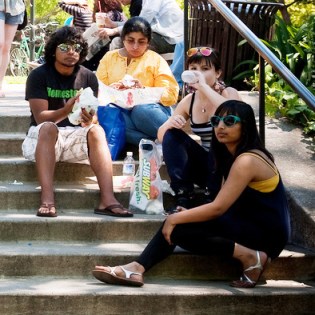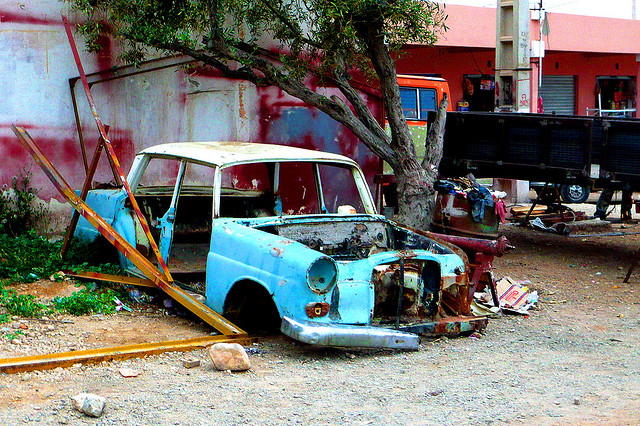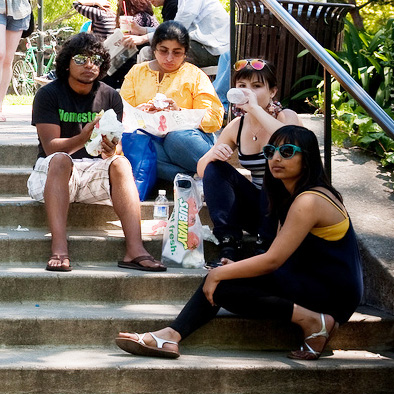
Berkeley students. (Photo by David Park.)
Fast food joints offer a quick and easy fix for hungry, busy students on college campuses. But at the University of California, they’ve also become a target for student activists intent on shifting their schools’ large dining budgets away from less healthy, industrially produced food and toward more sustainable options.
“Focusing on food is how a lot of students get passionate about issues of sustainability, some of which aren’t that sexy,” says Matt St. Clair, a former student activist who now manages all aspects of sustainability for the UC system (see their comprehensive policy on sustainable practices [PDF]), which spans across 10 campuses and five medical schools. In addition to working on the less sexy aspects of the shift, like energy efficiency and waste reduction, St. Clair has put food at the top of the list. Along with students, staff, and administrators, he is working to prioritize local, organic, and fairly produced food, while creating a policy that could have a huge impact on their burgers, tacos, and stir fry — if it’s executed right.
By 2020, 20 percent of the purchases made in UC dining facilities and fast food franchises on all campuses must meet one or more of 16 sustainable food criteria set by the Real Food Challenge, a national activist network focused on steering American colleges and universities toward sustainability. The Real Food Challenge list includes criteria such as: USDA certified organic, cage-free, grass-fed, fair trade, Marine Stewardship Council, and other third-party sustainable certifications. It also prioritizes “locally grown” — a factor that doesn’t always mean that much on its own in California.
For that reason, Ryan Galt, assistant professor of Agricultural Sustainability and Society at UC Davis, takes issue with the “locally grown” designation. “It’s a watered down definition of sustainability,” he says. “In most of California, local is easy because you’re within 500 miles of the Central Valley, which supplies most of the fruits and vegetables for the whole country.” And “local” doesn’t dictate anything about environmental or working conditions, he adds.
But UC Santa Cruz educator and activist Tim Galarneau, who proposed the sustainable food goals back in 2004, sees the “local” criteria as a good place for conventional suppliers to start to engage larger environmental and labor issues. He believes that St. Clair and the sustainable food steering committee, which is still under development, will then be in a position to inch the bar higher.
The campus dining halls at Berkeley, Davis, Santa Cruz, Santa Barbara, and San Diego have already exceeded the 20 percent goal in the past year, and many aim to get to 40 percent by 2020. In addition to some organic and fair trade ingredients, most of the shift has focused on local food. But all campuses have also made impressive strides in reducing food waste by ditching dining trays, which has led most diners to opt for less food per meal. Clint Jeffries, the green business manager at the UC Santa Cruz dining department, says that nixing the trays has not only reduced food waste by 35 percent and saved a million gallons of water each year, but “it has probably also helped some students avoid the freshman 15.” (The trays weren’t wasted, either; they were donated to artists and schools.)
For all campuses the most formidable challenge will likely be getting fast food vendors like SUBWAY, Domino’s Pizza, Jamba Juice, Burger King, and Panda Express to follow the examples set by the dining halls. Most franchises are part of a much larger supply chain, a fact that begs the question: Can the UC system really force them to change their practices?
St. Clair is optimistic. “Of course there’s pushback, but the campus food managers haven’t opposed the policy, and they will have to negotiate these terms into contracts with vendors,” he says.
David Schwartz, campaign director for the Real Food Challenge, believes that the entire fast food industry will be moving toward sustainability in the coming decade because of consumer demand. If that’s the case, the UC policy can be seen as an opportunity for these restaurants to get ahead of the pack. “If Domino’s isn’t figuring this out now,” he says, “in 10 years they will be wishing they had.”
But others see a struggle down the road. Sue Hawkins, director of dining services at UC Santa Barbara, has already informed her fast food tenants about the new policy, and says that it’s likely they will start offering compostable containers to meet more aggressive waste reduction goals. Yet she’s doubtful about their ability to source fair trade, organic, or local produce for just a few locations. “Most of these companies have hundreds, if not thousands, of stores across the country. The purchasing decisions they make are for all of their units, not just a couple,” she says.
Most fast food chains use third-party suppliers. So food service companies such as Sodexo and Aramark would be the real executors of the policy, should they choose to adhere to it. According to Galarneau, these companies have mutual back-scratching arrangements with big industrial suppliers who offer generous rebates in exchange for loyalty, making it hard for small, local producers to contract with a campus food service.
“We really need a big franchise partner to step up and say, ‘We want to make a difference,’” he says.
Jamba Juice is better poised than most chains to be that partner. While Domino’s, SUBWAY, and Burger King did not comment on the 2020 policy change for this article, Jamba Juice spokeswoman Janice Duis says that her company, which sources most oranges and wheatgrass locally and sells organic oats and granola, intends to work closely with the university to comply with the policy and remain on the five campuses where they currently have stores.
It’s possible that the 2020 policy could result in the mass exodus of corporate fast food from the University of California. But for the activists involved with the Real Food Challenge, that might not be such a bad thing. For one, it means that more campuses will start to resemble UC Santa Cruz. Smack in the middle of organic farming paradise, Santa Cruz has been able to eschew name-brand restaurants in favor of homegrown mom-and-pop shops that source their produce from local farmers co-ops. Galarneau says he would like to see, sprouting across the state like wildflowers, “new, regional-based franchises that cater to our vision and values.”



